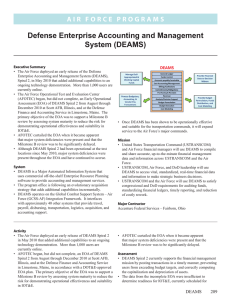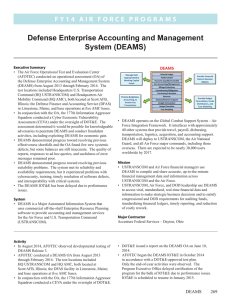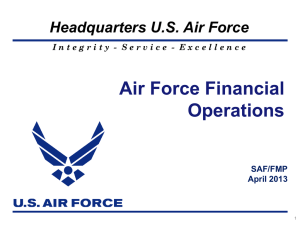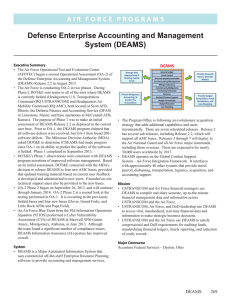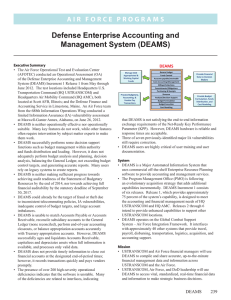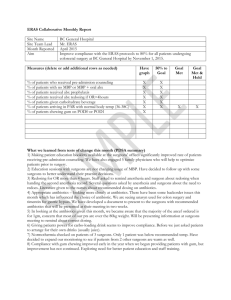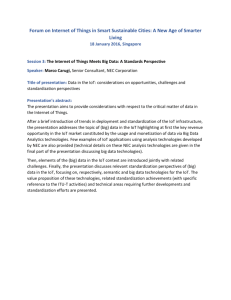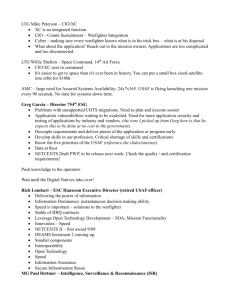Defense Enterprise Accounting and Management
advertisement
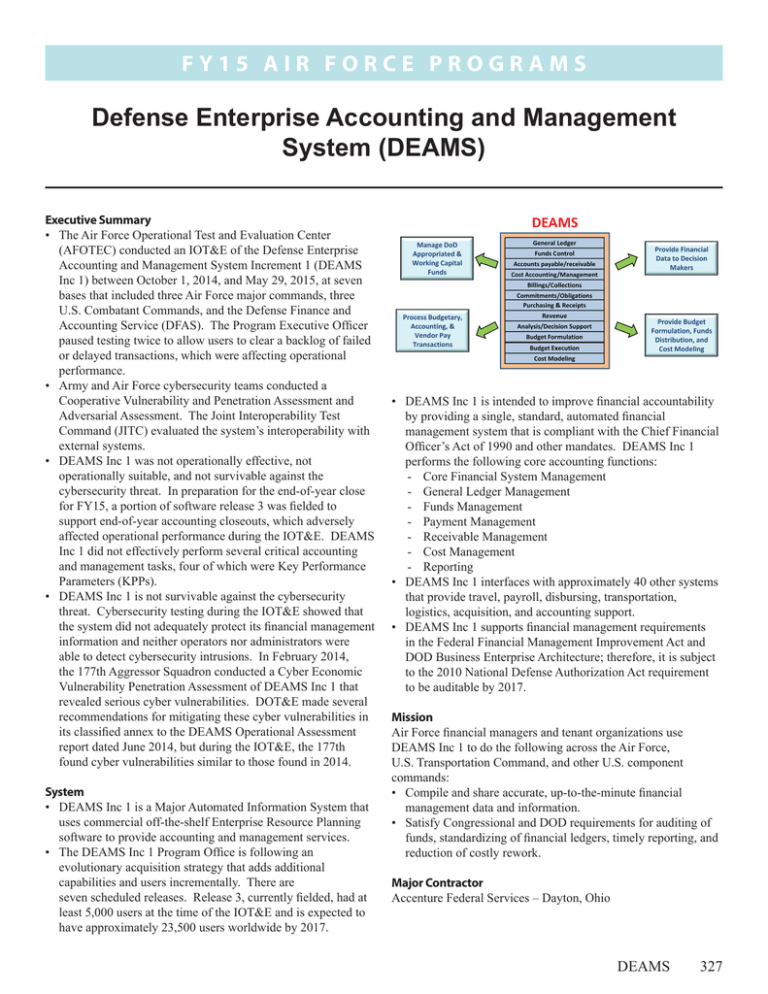
FY15 AIR FORCE PROGRAMS Defense Enterprise Accounting and Management System (DEAMS) Executive Summary • The Air Force Operational Test and Evaluation Center (AFOTEC) conducted an IOT&E of the Defense Enterprise Accounting and Management System Increment 1 (DEAMS Inc 1) between October 1, 2014, and May 29, 2015, at seven bases that included three Air Force major commands, three U.S. Combatant Commands, and the Defense Finance and Accounting Service (DFAS). The Program Executive Officer paused testing twice to allow users to clear a backlog of failed or delayed transactions, which were affecting operational performance. • Army and Air Force cybersecurity teams conducted a Cooperative Vulnerability and Penetration Assessment and Adversarial Assessment. The Joint Interoperability Test Command (JITC) evaluated the system’s interoperability with external systems. • DEAMS Inc 1 was not operationally effective, not operationally suitable, and not survivable against the cybersecurity threat. In preparation for the end-of-year close for FY15, a portion of software release 3 was fielded to support end-of-year accounting closeouts, which adversely affected operational performance during the IOT&E. DEAMS Inc 1 did not effectively perform several critical accounting and management tasks, four of which were Key Performance Parameters (KPPs). • DEAMS Inc 1 is not survivable against the cybersecurity threat. Cybersecurity testing during the IOT&E showed that the system did not adequately protect its financial management information and neither operators nor administrators were able to detect cybersecurity intrusions. In February 2014, the 177th Aggressor Squadron conducted a Cyber Economic Vulnerability Penetration Assessment of DEAMS Inc 1 that revealed serious cyber vulnerabilities. DOT&E made several recommendations for mitigating these cyber vulnerabilities in its classified annex to the DEAMS Operational Assessment report dated June 2014, but during the IOT&E, the 177th found cyber vulnerabilities similar to those found in 2014. System • DEAMS Inc 1 is a Major Automated Information System that uses commercial off-the-shelf Enterprise Resource Planning software to provide accounting and management services. • The DEAMS Inc 1 Program Office is following an evolutionary acquisition strategy that adds additional capabilities and users incrementally. There are seven scheduled releases. Release 3, currently fielded, had at least 5,000 users at the time of the IOT&E and is expected to have approximately 23,500 users worldwide by 2017. • DEAMS Inc 1 is intended to improve financial accountability by providing a single, standard, automated financial management system that is compliant with the Chief Financial Officer’s Act of 1990 and other mandates. DEAMS Inc 1 performs the following core accounting functions: - Core Financial System Management - General Ledger Management - Funds Management - Payment Management - Receivable Management - Cost Management - Reporting • DEAMS Inc 1 interfaces with approximately 40 other systems that provide travel, payroll, disbursing, transportation, logistics, acquisition, and accounting support. • DEAMS Inc 1 supports financial management requirements in the Federal Financial Management Improvement Act and DOD Business Enterprise Architecture; therefore, it is subject to the 2010 National Defense Authorization Act requirement to be auditable by 2017. Mission Air Force financial managers and tenant organizations use DEAMS Inc 1 to do the following across the Air Force, U.S. Transportation Command, and other U.S. component commands: • Compile and share accurate, up-to-the-minute financial management data and information. • Satisfy Congressional and DOD requirements for auditing of funds, standardizing of financial ledgers, timely reporting, and reduction of costly rework. Major Contractor Accenture Federal Services – Dayton, Ohio DEAMS 327 FY15 AIR FORCE PROGRAMS Activity • AFOTEC conducted an IOT&E of DEAMS Inc 1 between October 1, 2014, and May 29, 2015, at seven Air Force bases that included three Air Force major commands, three U.S. Combatant Commands, and DFAS at Limestone, Maine. • The IOT&E did not run continuously during the 8-month period. The Program Executive Officer paused testing twice with DOT&E approval to allow Air Force financial managers and DFAS to clear a backlog of failed or delayed transactions, affecting operational performance of DEAMS Inc 1. • In conjunction with the IOT&E, the Army Research Laboratory in White Sands Missile Range, New Mexico, conducted a cybersecurity Cooperative Vulnerability and Penetration Assessment at Maxwell AFB – Gunter Annex, Alabama. The 177th Information Aggressor Squadron followed this up with an Adversarial Assessment at McConnell AFB, Kansas. • In August 2015, DOT&E submitted an IOT&E report with a classified annex detailing the results of the IOT&E testing. • JITC evaluated DEAMS Inc 1 interoperability with external systems. • AFOTEC conducted the IOT&E in accordance with the DOT&E-approved Test and Evaluation Master Plan and the test plan. Assessment • DEAMS Inc 1 demonstrated good progress during the second operational assessment in 2014, but a portion of software release 3 was fielded between the second operational assessment and IOT&E to support end-of-year accounting closeouts, which adversely affected operational performance during the IOT&E. • DEAMS Inc 1 was not operationally effective. DEAMS Inc 1 did not effectively perform several critical accounting and management tasks, four of which were KPPs. - DEAMS Inc 1 failed to correctly balance available funds, close end-of-year accounts within the time frame prescribed by the Air Force, meet the 95 percent thresholds for balancing end-of-quarter and end-of-month accounts, and record transactions in a timely manner. - Poor DEAMS performance resulted in an increase in late penalty payments to $465.7 4 per $1 Million in January 2015, which was nearly 10 times the Air Force’s FY15 goal of $49.00 per $1 Million. - DEAMS Inc 1 failed to process some transactions during IOT&E, resulting in a backlog of failed or delayed transactions. The DFAS users’ workload increased as they tried to reduce the backlog. DEAMS usability will continue to be degraded until the backlog is reduced. • Problems with DEAMS Inc 1’s reporting tool (Discoverer) have been noted during the IOT&E and during previous DEAMS Inc 1 operational testing. Enhancements to DEAMS Inc 1 intended to correct reporting defects, including the Oracle Business Intelligence Enterprise Edition (OBIEE), were not fielded for the IOT&E, even though OBIEE was 328 DEAMS • • • • • included in release 3 according to the DEAMS acquisition strategy. While OBIEE was not ready and not fielded, when it is fielded, it is expected to provide improved reporting. IOT&E survey results indicated that 48 percent of users did not use DEAMS Inc 1 for status of funds reporting, budget analysis and planning, or decision support, which meant that for this set of users, DEAMS Inc 1 reporting functionality was not being used for financial decision-making as intended. DEAMS Inc 1 is not operationally suitable. DEAMS Inc 1 continues to exhibit problems with software reliability growth as measured by an increase in the number of high-severity deficiencies, including many that had remained unresolved for 240 days or longer. Configuration management procedures regarding regression testing of resolved defects were either not followed by the Program Office or were inadequate to ensure that the defects were actually corrected in the software. DEAMS Inc 1 also did not meet Net-Ready KPP requirements for the exchange of critical information as reported by JITC. The results of the interoperability assessment demonstrated that 5 of the 22 available critical interfaces did not meet the required information exchange requirements. Although DEAMS Inc 1 training demonstrated gradual improvement since the second operational assessment, the training did not prepare most users to employ DEAMS Inc 1 effectively and did not provide knowledge to new users to adequately perform necessary accounting and reporting tasks. A long time gap between initial training and IOT&E degraded user proficiency, as much of what was learned had been forgotten. The training needs to align more closely with deployments rather than being given months in advance. Training alignment could prove a challenge for presently scheduled deployments to many thousands of new users and scores of new bases over the next year. In the June 2014 operational assessment report, DOT&E recommended that the Air Force modify DEAMS Inc 1 user training to focus more on functional understanding the DEAMS Inc 1 general ledger environment, rather than on navigation within the system. However, during the IOT&E, users indicated that the training focused on how to navigate within DEAMS Inc 1 rather than how to perform missions in the DEAMS Inc 1 environment. Additionally, the business process changes that accompanied DEAMS Inc 1 implementation were not intuitive to the users based upon their experience with legacy systems. Accordingly, users were not readily able to accomplish their tasks. Training that focuses on providing functional understanding will improve the suitability of DEAMS Inc 1. DEAMS Inc 1 is not survivable against the cybersecurity threat. In February 2014, the 177th Aggressor Squadron conducted a Cyber Economic Vulnerability Penetration Assessment of DEAMS Inc 1 that revealed serious cyber vulnerabilities. Cybersecurity testing showed that the system did not adequately protect its financial management information and neither operators nor administrators were able to detect cybersecurity intrusions. DOT&E made several FY15 AIR FORCE PROGRAMS recommendations for mitigating these vulnerabilities in its classified annex to the DEAMS Operational Assessment report dated June 2014, but during the IOT&E, the 177th found vulnerabilities similar to those found in 2014. Recommendations • Status of Previous Recommendations. The Program Office did not implement FY14 recommendations successfully and still needs to: 1. Correct balance accuracy defects to meet KPP requirements and to demonstrate progress towards DEAMS Inc 1 achieving of full auditability. 2. Address cybersecurity recommendations provided in DOT&E’s classified annex to the DEAMS Operational Assessment report. • FY15 Recommendations. The DEAMS program manager should: 1. Identify and implement processes, procedures, and software improvements to clear the transaction backlog to fix the lag time between transaction and posting and ensure accurate and timely reporting. 2. Work with the DFAS to identify the root causes of imbalances between DEAMS Inc 1 and Treasury and change policies and procedures or implement software improvements to prevent further imbalances. 3. Conduct regression testing to improve DEAMS Inc 1 performance and identify potential interface problems before fielding software updates and releases. 4. Provide DEAMS Inc 1 training that prepares users to effectively employ DEAMS Inc 1 upon fielding. 5. Work with AFOTEC to conduct follow-on operational testing to verify that the deficiencies have been corrected and that the new reporting tool is operationally effective, suitable, and cyber-secure, once corrections have been made and a new reporting tool has been fielded. DEAMS 329 FY15 AIR FORCE PROGRAMS 330
